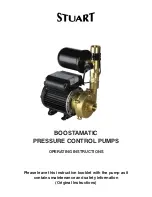
Overtemperature
Each compressor has an internal protector to protect it against
excessively high discharge gas temperatures.
Crankcase Heater
Each compressor has a 125-watt crankcase heater to prevent
absorption of liquid refrigerant by oil in the crankcase when
the compressor is idle. Since power for the crankcase heaters
is drawn from the unit incoming power, main unit power must
be on for the heaters to be energized.
IMPORTANT:
After a prolonged shutdown or service job, en-
ergize the crankcase heaters for 24 hours before starting the
compressors.
Compressor Lockout
If any of the safeties (high- or low-pressure, freeze protection
thermostat, compressor internal thermostat) trip, or if there
is loss of power to the compressors, the cooling lockout (CLO)
will lock the compressors off. To reset, manually move the
thermostat setting.
B. Indoor-Fan Motor Protection
A manual reset, calibrated trip, magnetic circuit breaker pro-
tects against overcurrent. Do not bypass connections or in-
crease the size of the breaker to correct trouble. Determine
the cause and correct it before resetting the breaker.
C. Outdoor-Fan Motor Protection
Each outdoor-fan motor is internally protected against
overtemperature.
D. High- and Low-Pressure Switches
If either switch trips, or if the compressor overtemperature
switch activates, that refrigerant circuit will be automati-
cally locked out by the CLO. To reset, manually move the ther-
mostat setting.
E. Freeze Protection Thermostat (FPT)
An FPT is located on the indoor coil. It detects frost build-up
and turns off the compressor, allowing the coil to clear. Once
the frost has melted, the compressor can be reenergized.
X. RELIEF DEVICES
All units have relief devices to protect against damage from
excessive pressures (i.e., fire). These devices protect the high
and low side.
XI. CONTROL CIRCUIT, 24 V
This control circuit is protected against overcurrent by a
3.2 amp circuit breaker. Breaker can be reset. If it trips, de-
termine cause of trouble before resetting.
XII. REPLACEMENT PARTS
A complete list of replacement parts may be obtained from
any distributor upon request.
TROUBLESHOOTING
Refer to Table 13, Fig. 32 and 33, and the troubleshooting
charts on pages 29 and 30 for assistance when troubleshoot-
ing the 542J units.
Table 13 — Check Valve Functions
CHECK VALVE
IDENTIFICATION
(See Fig. 32)
LOCATION
COOLING
CYCLE
HEATING
CYCLE
COOLING CYCLE
CHECK VALVE STUCK
HEATING CYCLE
CHECK VALVE STUCK
Open
Closed
Open
Closed
A
Outdoor coil;
Header
Closed
Open
Loose circuiting in
outdoor coil. Acts
like low charge.
Normal
Normal
Bottom 3 circuits
restricted
B
Outdoor coil;
Liquid line
feeding
fixed orifice
Open
Closed
Normal
Lose some
capacity
Restricted outdoor
fixed orifice
Normal
C
Outdoor coil;
Liquid line
leaving coil
Closed
Open
Restricted
liquid line
Normal
Normal
Flooding outdoor
coil and compressor
D
Indoor coil;
Liquid line
feeding
fixed orifice
Open
Closed
Normal
Restricted
indoor
fixed orifice
Lose some capacity
Normal
E
Indoor coil;
Liquid line
leaving coil
Closed
Open
Bypasses coil and
floods compressor
Normal
Normal
Restricted
liquid line
F
Indoor coil;
Header
Open
Closed
Normal
Bottom
circuits
of indoor
coil inactive
Loose indoor coil
circuiting — symptom
of low charge
Normal
—24—
Содержание 542J Series
Страница 28: ...Fig 33 Typical Label Diagram Schematic 542J180 208 230 V 60 Hz Unit Shown cont 28...
Страница 29: ...TROUBLESHOOTING CHART HEATING CYCLE ODT Outdoor Temperature 29...
Страница 30: ...TROUBLESHOOTING CHART COOLING CYCLE Copyright 1997 Carrier Corporation CATALOG NO BDP 3354 237...
Страница 31: ......









































